COUNTABLE AND UNCOUNTABLE NOUNS
Download as pptx, pdf1 like1,209 views
EXAMPLES EXERCISES
1 of 11
Downloaded 33 times
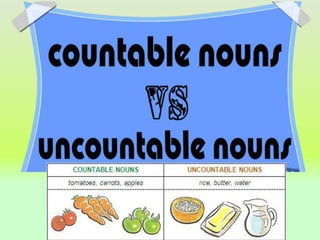
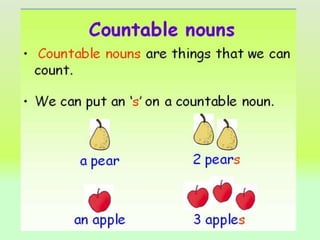


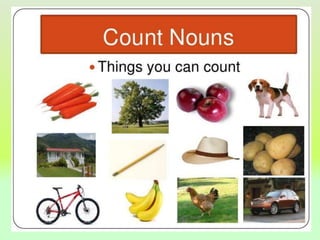

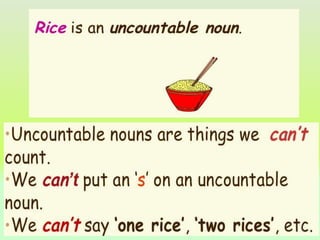


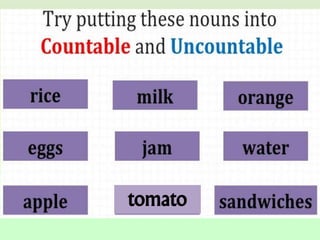

Ad
Recommended
QUESTIONS TAGS
QUESTIONS TAGSDiana Carolina Flores Uceda
Ã˝
Question tags are short questions added to the end of statements to confirm if something is true or encourage a reply. A positive statement is followed by a negative question tag, while a negative statement uses a positive question tag. Question tags are formed using an auxiliary or modal verb matching the tense of the statement.Howmuchandmany 150820203237-lva1-app6892
Howmuchandmany 150820203237-lva1-app6892Sheyla S√°nchez Pacheco
Ã˝
This document discusses countable and uncountable nouns and provides examples of questions using "how many" or "how much" depending on whether the noun is countable or uncountable. It also lists prices for various items to demonstrate when to use "how much is" or "how much are".How much and how many
How much and how manyDiana Carolina Flores Uceda
Ã˝
This document discusses countable and uncountable nouns. It provides examples of using "is" or "are" with countable singular nouns like "car" versus uncountable plural nouns like "cars". It also lists question words used with countable versus uncountable nouns.Exercises used to
Exercises used toDiana Carolina Flores Uceda
Ã˝
The document discusses things that people used to do in the past but no longer do, such as playing the piano, living in London, and going to the same school as a sister. It also mentions things people didn't used to do, like liking techno music, drinking coffee, having their own bedroom, eating certain foods, playing or speaking certain ways, wearing specific clothes, living in a place, or doing particular activities. The document contrasts actions people were accustomed to in the past with things they no longer do regularly using phrases with "used to" and "didn't use to".Countable and uncountable book
Countable and uncountable bookDiana Carolina Flores Uceda
Ã˝
This document provides examples of singular and plural forms of verbs. It shows the verbs "is" and "are" used with both singular and plural nouns, with "is" used for singular nouns and "are" used for plural nouns. An exercise is included to practice using the correct verb form with singular and plural subjects.Personality adjectives
Personality adjectivesDiana Carolina Flores Uceda
Ã˝
The document lists pairs of adjectives describing different personality traits, with one adjective in each pair representing a positive trait and the other representing its negative counterpart. Some of the pairs included are kind/unkind, honest/dishonest, cheerful/depressed, friendly/unfriendly, thoughtful/thoughtless, modest/arrogant, responsible/irresponsible, and tactful/tactless.Comic project
Comic projectDiana Carolina Flores Uceda
Ã˝
This document appears to be a series of dialogues between two students on their first day of school. In the dialogues, the students introduce themselves, share that they are both feeling nervous about their first day, and discuss their classes, teachers, friends and plans to play with their new friends. They wish each other well before it's time for break.PAST SIMPLE - REGULAR VERBS
PAST SIMPLE - REGULAR VERBS Diana Carolina Flores Uceda
Ã˝
The document provides rules for forming the past simple tense of regular verbs in English. It states that for most regular verbs ending in a consonant, we add "-ed" to form the past tense. For verbs ending in "e", we add "d". For verbs ending in a consonant + "y", we change the "y" to "ied". And for one-syllable verbs ending in a consonant-vowel-consonant, we double the final consonant before adding "-ed". Examples are given for each rule to illustrate how to form the past tense of different types of regular verbs.Describing animals
Describing animalsDiana Carolina Flores Uceda
Ã˝
The document describes a blue dolphin that lives in the sea. It has fins but no legs. The dolphin states its physical attributes and habitat.Animals
AnimalsDiana Carolina Flores Uceda
Ã˝
This document introduces several common animals including a kangaroo, panda, dolphin, whale, shark, bat, lion, bear, and bird. It asks the reader to identify each animal shown and engage with what animals they know by naming them.Past simple passive
Past simple passive Diana Carolina Flores Uceda
Ã˝
The document discusses the past simple passive tense in English. It provides examples of singular and plural subjects and objects in the past simple passive form, including "the dynamite was invented by Alfred Novel" and "airplanes were invented by The Wright brothers". It also lists common past participles like "carried", "built", and "cut" and example sentences in the past simple passive tense such as "the box was carried by the woman".TOO VS. NOT ... ENOUGH
TOO VS. NOT ... ENOUGH Diana Carolina Flores Uceda
Ã˝
The document discusses that something is not enough of an adjective to describe a situation. It provides an example where the water is not hot enough to take a shower, suggesting it is not adjective enough to meet the needs or desires. The document is brief and does not provide much contextual information to draw from.Some any
Some anyDiana Carolina Flores Uceda
Ã˝
Some and any can both be used with singular or plural nouns. Some is used to refer to an unspecified or unknown amount of something, while any refers to even one or a small number of things. We use some to indicate an affirmative possibility, and any to indicate possibility regardless of quantity or lack of preference.Superlatives- GRAMMAR AND EXAMPLES
Superlatives- GRAMMAR AND EXAMPLESDiana Carolina Flores Uceda
Ã˝
This document provides a table comparing adjectives in their positive, comparative, and superlative forms. It shows that one-syllable adjectives form the superlative with "the most" plus the adjective, while longer adjectives simply add "-est" to form the superlative.Modals for speculation
Modals for speculationDiana Carolina Flores Uceda
Ã˝
The document discusses modals used for speculation in English. It explains that "must" is used when something is sure to be possible or true, "can't" is used when something is sure to not be possible, and "might", "may", and "could" are used when the speaker is unsure. It provides examples of changing sentences to use these modals correctly based on levels of certainty. The document concludes by having the reader make sentences using pictures and modals to express different levels of speculation.So do i neither do i
So do i neither do i Diana Carolina Flores Uceda
Ã˝
The document provides examples of sentences that can be used to agree or disagree with statements using phrases like "So do I", "Neither do I", "I do!", and "I don't!". It gives sample statements and prompts the reader to agree or disagree with their partner's statements using those phrases. It also includes examples of rephrasing statements to disagree using phrases like "I don't", "I can't", "I am not", etc.Illnesses: WHAT'S THE MATTER?
Illnesses: WHAT'S THE MATTER?Diana Carolina Flores Uceda
Ã˝
The document lists various common illnesses and injuries that someone might have, including a cold with a runny nose and fever, a sore throat, cough, headache, toothache, measles, stomach ache, broken leg, sunburn, bruise, and cut. It asks "What's the matter with you?" for each one, indicating the person is sick with various symptoms and conditions.Made of affirmative negative
Made of affirmative negativeDiana Carolina Flores Uceda
Ã˝
This document discusses the grammar used with the phrase "made of" including whether to use affirmative or negative forms, and singular or plural verbs depending on the subject. It provides examples of using "made of" with different materials to illustrate these grammar points.Used to
Used toDiana Carolina Flores Uceda
Ã˝
The document discusses a child named Richard who used to look at pictures and make sentences. It implies that Richard no longer engages in this activity by stating "Richard used to... now he...". The document provides very little context and does not explicitly state what Richard now does instead.Demonstrative adjectives slides
Demonstrative adjectives slidesDiana Carolina Flores Uceda
Ã˝
This document discusses demonstrative adjectives and provides examples of their singular and plural forms depending on distance from the speaker or object. Demonstrative adjectives include this/these for nearby objects and that/those for objects farther away, with singular forms used for one object and plural forms for multiple objects.Illnesses : Vocabulary and exercises
Illnesses : Vocabulary and exercises Diana Carolina Flores Uceda
Ã˝
This document lists common illnesses and symptoms such as a temperature, cough, headache, stomach ache, toothache, earache, and backache. It also notes that someone "He's got, She's got, They've got" an illness and encourages playing charades or using an activity book.Present continuous future plans
Present continuous future plansDiana Carolina Flores Uceda
Ã˝
Sophie and Sam are spending their Sunday evening at home. The document asks what activities the reader has planned for their upcoming Saturday and provides grammar rules for changing words from affirmative to negative to interrogative forms by eliminating or changing final letters.Measuring, learning and applying multiplication facts.
Measuring, learning and applying multiplication facts.cgilmore6
Ã˝
∫›∫›fl£s from a presentation by Professor Camilla Gilmore to the Association of Teachers of Mathematics and Mathematics Association Primary Interest group in June 2025.
This gave an overview of two studies that investigated children's multiplication fact knowledge. These studies were part of the SUM research project based at the University of Nottingham and Loughborough University. For more information see www.sumproject.org.ukjune 10 2025 ppt for madden on art science is over.pptx
june 10 2025 ppt for madden on art science is over.pptxroger malina
Ã˝
art science is over -talk by roger malina for jack madden groupMore Related Content
More from Diana Carolina Flores Uceda (20)
PAST SIMPLE - REGULAR VERBS
PAST SIMPLE - REGULAR VERBS Diana Carolina Flores Uceda
Ã˝
The document provides rules for forming the past simple tense of regular verbs in English. It states that for most regular verbs ending in a consonant, we add "-ed" to form the past tense. For verbs ending in "e", we add "d". For verbs ending in a consonant + "y", we change the "y" to "ied". And for one-syllable verbs ending in a consonant-vowel-consonant, we double the final consonant before adding "-ed". Examples are given for each rule to illustrate how to form the past tense of different types of regular verbs.Describing animals
Describing animalsDiana Carolina Flores Uceda
Ã˝
The document describes a blue dolphin that lives in the sea. It has fins but no legs. The dolphin states its physical attributes and habitat.Animals
AnimalsDiana Carolina Flores Uceda
Ã˝
This document introduces several common animals including a kangaroo, panda, dolphin, whale, shark, bat, lion, bear, and bird. It asks the reader to identify each animal shown and engage with what animals they know by naming them.Past simple passive
Past simple passive Diana Carolina Flores Uceda
Ã˝
The document discusses the past simple passive tense in English. It provides examples of singular and plural subjects and objects in the past simple passive form, including "the dynamite was invented by Alfred Novel" and "airplanes were invented by The Wright brothers". It also lists common past participles like "carried", "built", and "cut" and example sentences in the past simple passive tense such as "the box was carried by the woman".TOO VS. NOT ... ENOUGH
TOO VS. NOT ... ENOUGH Diana Carolina Flores Uceda
Ã˝
The document discusses that something is not enough of an adjective to describe a situation. It provides an example where the water is not hot enough to take a shower, suggesting it is not adjective enough to meet the needs or desires. The document is brief and does not provide much contextual information to draw from.Some any
Some anyDiana Carolina Flores Uceda
Ã˝
Some and any can both be used with singular or plural nouns. Some is used to refer to an unspecified or unknown amount of something, while any refers to even one or a small number of things. We use some to indicate an affirmative possibility, and any to indicate possibility regardless of quantity or lack of preference.Superlatives- GRAMMAR AND EXAMPLES
Superlatives- GRAMMAR AND EXAMPLESDiana Carolina Flores Uceda
Ã˝
This document provides a table comparing adjectives in their positive, comparative, and superlative forms. It shows that one-syllable adjectives form the superlative with "the most" plus the adjective, while longer adjectives simply add "-est" to form the superlative.Modals for speculation
Modals for speculationDiana Carolina Flores Uceda
Ã˝
The document discusses modals used for speculation in English. It explains that "must" is used when something is sure to be possible or true, "can't" is used when something is sure to not be possible, and "might", "may", and "could" are used when the speaker is unsure. It provides examples of changing sentences to use these modals correctly based on levels of certainty. The document concludes by having the reader make sentences using pictures and modals to express different levels of speculation.So do i neither do i
So do i neither do i Diana Carolina Flores Uceda
Ã˝
The document provides examples of sentences that can be used to agree or disagree with statements using phrases like "So do I", "Neither do I", "I do!", and "I don't!". It gives sample statements and prompts the reader to agree or disagree with their partner's statements using those phrases. It also includes examples of rephrasing statements to disagree using phrases like "I don't", "I can't", "I am not", etc.Illnesses: WHAT'S THE MATTER?
Illnesses: WHAT'S THE MATTER?Diana Carolina Flores Uceda
Ã˝
The document lists various common illnesses and injuries that someone might have, including a cold with a runny nose and fever, a sore throat, cough, headache, toothache, measles, stomach ache, broken leg, sunburn, bruise, and cut. It asks "What's the matter with you?" for each one, indicating the person is sick with various symptoms and conditions.Made of affirmative negative
Made of affirmative negativeDiana Carolina Flores Uceda
Ã˝
This document discusses the grammar used with the phrase "made of" including whether to use affirmative or negative forms, and singular or plural verbs depending on the subject. It provides examples of using "made of" with different materials to illustrate these grammar points.Used to
Used toDiana Carolina Flores Uceda
Ã˝
The document discusses a child named Richard who used to look at pictures and make sentences. It implies that Richard no longer engages in this activity by stating "Richard used to... now he...". The document provides very little context and does not explicitly state what Richard now does instead.Demonstrative adjectives slides
Demonstrative adjectives slidesDiana Carolina Flores Uceda
Ã˝
This document discusses demonstrative adjectives and provides examples of their singular and plural forms depending on distance from the speaker or object. Demonstrative adjectives include this/these for nearby objects and that/those for objects farther away, with singular forms used for one object and plural forms for multiple objects.Illnesses : Vocabulary and exercises
Illnesses : Vocabulary and exercises Diana Carolina Flores Uceda
Ã˝
This document lists common illnesses and symptoms such as a temperature, cough, headache, stomach ache, toothache, earache, and backache. It also notes that someone "He's got, She's got, They've got" an illness and encourages playing charades or using an activity book.Present continuous future plans
Present continuous future plansDiana Carolina Flores Uceda
Ã˝
Sophie and Sam are spending their Sunday evening at home. The document asks what activities the reader has planned for their upcoming Saturday and provides grammar rules for changing words from affirmative to negative to interrogative forms by eliminating or changing final letters.Recently uploaded (20)
Measuring, learning and applying multiplication facts.
Measuring, learning and applying multiplication facts.cgilmore6
Ã˝
∫›∫›fl£s from a presentation by Professor Camilla Gilmore to the Association of Teachers of Mathematics and Mathematics Association Primary Interest group in June 2025.
This gave an overview of two studies that investigated children's multiplication fact knowledge. These studies were part of the SUM research project based at the University of Nottingham and Loughborough University. For more information see www.sumproject.org.ukjune 10 2025 ppt for madden on art science is over.pptx
june 10 2025 ppt for madden on art science is over.pptxroger malina
Ã˝
art science is over -talk by roger malina for jack madden group2025 June Year 9 Presentation: Subject selection.pptx
2025 June Year 9 Presentation: Subject selection.pptxmansk2
Ã˝
2025 June Year 9 Presentation: Subject selectionNon-Communicable Diseases and National Health Programs – Unit 10 | B.Sc Nursi...
Non-Communicable Diseases and National Health Programs – Unit 10 | B.Sc Nursi...RAKESH SAJJAN
Ã˝
This PowerPoint presentation is prepared for Unit 10 – Non-Communicable Diseases and National Health Programs, as per the 5th Semester B.Sc Nursing syllabus outlined by the Indian Nursing Council (INC) under the subject Community Health Nursing – I.
This unit focuses on equipping students with knowledge of the causes, prevention, and control of non-communicable diseases (NCDs), which are a major public health challenge in India. The presentation emphasizes the nurse’s role in early detection, screening, management, and referral services under national-level programs.
üîπ Key Topics Included:
Definition, burden, and impact of NCDs in India
Epidemiology, risk factors, signs/symptoms, prevention, and management of:
Diabetes Mellitus
Hypertension
Cardiovascular Diseases
Stroke & Obesity
Thyroid Disorders
Blindness
Deafness
Injuries and Accidents (incl. road traffic injuries and trauma guidelines)
NCD-2 Cancers:
Breast Cancer
Cervical Cancer
Oral Cancer
Risk factors, screening, diagnosis, early signs, referral & palliative care
Role of nurse in screening, referral, counseling, and continuum of care
National Programs:
National Program for Prevention and Control of Cancer, Diabetes, Cardiovascular Diseases and Stroke (NPCDCS)
National Program for Control of Blindness
National Program for Prevention and Control of Deafness
National Tobacco Control Program (NTCP)
Introduction to Universal Health Coverage and Ayushman Bharat
Use of standard treatment protocols and referral flowcharts
This presentation is ideal for:
Classroom lectures, field assignments, health education planning, and student projects
Preparing for university exams, class tests, and community field postingsEnergy Balances Of Oecd Countries 2011 Iea Statistics 1st Edition Oecd
Energy Balances Of Oecd Countries 2011 Iea Statistics 1st Edition Oecdrazelitouali
Ã˝
Energy Balances Of Oecd Countries 2011 Iea Statistics 1st Edition Oecd
Energy Balances Of Oecd Countries 2011 Iea Statistics 1st Edition Oecd
Energy Balances Of Oecd Countries 2011 Iea Statistics 1st Edition OecdICT-8-Module-REVISED-K-10-CURRICULUM.pdf
ICT-8-Module-REVISED-K-10-CURRICULUM.pdfpenafloridaarlyn
Ã˝
In this module, you will discover how digital tools, systems, and platforms empower people, businesses, and communities in the modern world. As 21st-century learners, you are part of a generation that lives and learns in a digital environment. This module is designed to guide you in exploring how ICT serves as a powerful tool—not only for communication but also for innovation, entrepreneurship, and responsible citizenship. Throughout this learning material, you will examine how ICT is used in real-world scenarios such as online marketing, digital citizenship, and legal and ethical issues in technology use. You’ll gain practical knowledge and skills, from creating websites and managing e-commerce platforms, to analyzing data and practicing safe and responsible behavior online.
By engaging with the lessons, activities, and performance tasks in this module, you will become more than just a technology user—you will be a responsible, informed, and empowered digital citizen ready to thrive in today’s interconnected world.
Let’s begin this journey and unlock the full potential of ICT in your everyday life!
How to Manage Multi Language for Invoice in Odoo 18
How to Manage Multi Language for Invoice in Odoo 18Celine George
Ã˝
Odoo supports multi-language functionality for invoices, allowing you to generate invoices in your customers’ preferred languages. Multi-language support for invoices is crucial for businesses operating in global markets or dealing with customers from different linguistic backgrounds. BINARY files CSV files JSON files with example.pptx
BINARY files CSV files JSON files with example.pptxRamakrishna Reddy Bijjam
Ã˝
BINARY FILES, CSV FILESROLE PLAY: FIRST AID -CPR & RECOVERY POSITION.pptx
ROLE PLAY: FIRST AID -CPR & RECOVERY POSITION.pptxBelicia R.S
Ã˝
Role play : First Aid- CPR, Recovery position and Hand hygiene.
Scene 1: Three friends are shopping in a mall
Scene 2: One of the friend becomes victim to electric shock.
Scene 3: Arrival of a first aider
Steps:
Safety First
Evaluate the victim‘s condition
Call for help
Perform CPR- Secure an open airway, Chest compression, Recuse breaths.
Put the victim in Recovery position if unconscious and breathing normally.
Paper 107 | From Watchdog to Lapdog: Ishiguro’s Fiction and the Rise of “Godi...
Paper 107 | From Watchdog to Lapdog: Ishiguro’s Fiction and the Rise of “Godi...Rajdeep Bavaliya
Ã˝
Dive into a captivating analysis where Kazuo Ishiguro’s nuanced fiction meets the stark realities of post‑2014 Indian journalism. Uncover how “Godi Media” turned from watchdog to lapdog, echoing the moral compromises of Ishiguro’s protagonists. We’ll draw parallels between restrained narrative silences and sensationalist headlines—are our media heroes or traitors? Don’t forget to follow for more deep dives!
M.A. Sem - 2 | Presentation
Presentation Season - 2
Paper - 107: The Twentieth Century Literature: From World War II to the End of the Century
Submitted Date: April 4, 2025
Paper Name: The Twentieth Century Literature: From World War II to the End of the Century
Topic: From Watchdog to Lapdog: Ishiguro’s Fiction and the Rise of “Godi Media” in Post-2014 Indian Journalism
[Please copy the link and paste it into any web browser to access the content.]
Video Link: https://youtu.be/kIEqwzhHJ54
For a more in-depth discussion of this presentation, please visit the full blog post at the following link: https://rajdeepbavaliya2.blogspot.com/2025/04/from-watchdog-to-lapdog-ishiguro-s-fiction-and-the-rise-of-godi-media-in-post-2014-indian-journalism.html
Please visit this blog to explore additional presentations from this season:
Hashtags:
#GodiMedia #Ishiguro #MediaEthics #WatchdogVsLapdog #IndianJournalism #PressFreedom #LiteraryCritique #AnArtistOfTheFloatingWorld #MediaCapture #KazuoIshiguro
Keyword Tags:
Godi Media, Ishiguro fiction, post-2014 Indian journalism, media capture, Kazuo Ishiguro analysis, watchdog to lapdog, press freedom India, media ethics, literature and media, An Artist of the Floating WorldPEST OF WHEAT SORGHUM BAJRA and MINOR MILLETS.pptx
PEST OF WHEAT SORGHUM BAJRA and MINOR MILLETS.pptxArshad Shaikh
Ã˝
Wheat, sorghum, and bajra (pearl millet) are susceptible to various pests that can significantly impact crop yields. Common pests include aphids, stem borers, shoot flies, and armyworms. Aphids feed on plant sap, weakening the plants, while stem borers and shoot flies damage the stems and shoots, leading to dead hearts and reduced growth. Armyworms, on the other hand, are voracious feeders that can cause extensive defoliation and grain damage. Effective management strategies, including resistant varieties, cultural practices, and targeted pesticide applications, are essential to mitigate pest damage and ensure healthy crop production.Chalukyas of Gujrat, Solanki Dynasty NEP.pptx
Chalukyas of Gujrat, Solanki Dynasty NEP.pptxDr. Ravi Shankar Arya Mahila P. G. College, Banaras Hindu University, Varanasi, India.
Ã˝
This presentation has been made keeping in mind the students of undergraduate and postgraduate level. In this slide try to present the brief history of Chaulukyas of Gujrat up to Kumarpala To keep the facts in a natural form and to display the material in more detail, the help of various books, websites and online medium has been taken. Whatever medium the material or facts have been taken from, an attempt has been made by the presenter to give their reference at the end.
Chaulukya or Solanki was one of the Rajputs born from Agnikul. In the Vadnagar inscription, the origin of this dynasty is told from Brahma's Chauluk or Kamandalu. They ruled in Gujarat from the latter half of the tenth century to the beginning of the thirteenth century. Their capital was in Anahilwad. It is not certain whether it had any relation with the Chalukya dynasty of the south or not. It is worth mentioning that the name of the dynasty of the south was 'Chaluky' while the dynasty of Gujarat has been called 'Chaulukya'. The rulers of this dynasty were the supporters and patrons of Jainism.Sustainable Innovation with Immersive Learning
Sustainable Innovation with Immersive LearningLeonel Morgado
Ã˝
Prof. Leonel and Prof. Dennis approached educational uses, practices, and strategies of using immersion as a lens to interpret, design, and planning educational activities in a sustainable way. Rather than one-off gimmicks, the intent is to enable instructors (and institutions) to be able to include them in their regular activities, including the ability to evaluate and redesign them.
Immersion as a phenomenon enables interpreting pedagogical activities in a learning-agnostic way: you take a stance on the learning theory to follow, and leverage immersion to envision and guide your practice.Revista digital preescolar en transformación
Revista digital preescolar en transformaciónguerragallardo26
Ã˝
EVOLUCIÓN DEL CONTENIDO DE LA EVALUACIÓN DE LOS RECURSOS Y DE LA FORMACIÓN DE LOS DOCENTESRay Dalio How Countries go Broke the Big Cycle
Ray Dalio How Countries go Broke the Big CycleDadang Solihin
Ã˝
A complete and practical understanding of the Big Debt Cycle. A much more practical understanding of how supply and demand really work compared to the conventional economic thinking. A complete and practical understanding of the Overall Big Cycle, which is driven by the Big Debt Cycle and the other major cycles, including the big political cycle within countries that changes political orders and the big geopolitical cycle that changes world orders.BUSINESS QUIZ PRELIMS | QUIZ CLUB OF PSGCAS | 9 SEPTEMBER 2024
BUSINESS QUIZ PRELIMS | QUIZ CLUB OF PSGCAS | 9 SEPTEMBER 2024Quiz Club of PSG College of Arts & Science
Ã˝
THE QUIZ CLUB OF PSGCAS BRINGS T0 YOU A FUN-FILLED, SEAT EDGE BUSINESS QUIZ
DIVE INTO THE PRELIMS OF BIZCOM 2024
QM: GOWTHAM S
BCom (2022-25)
THE QUIZ CLUB OF PSGCAS
Paper 107 | From Watchdog to Lapdog: Ishiguro’s Fiction and the Rise of “Godi...
Paper 107 | From Watchdog to Lapdog: Ishiguro’s Fiction and the Rise of “Godi...Rajdeep Bavaliya
Ã˝
Chalukyas of Gujrat, Solanki Dynasty NEP.pptx
Chalukyas of Gujrat, Solanki Dynasty NEP.pptxDr. Ravi Shankar Arya Mahila P. G. College, Banaras Hindu University, Varanasi, India.
Ã˝
BUSINESS QUIZ PRELIMS | QUIZ CLUB OF PSGCAS | 9 SEPTEMBER 2024
BUSINESS QUIZ PRELIMS | QUIZ CLUB OF PSGCAS | 9 SEPTEMBER 2024Quiz Club of PSG College of Arts & Science
Ã˝
Ad
